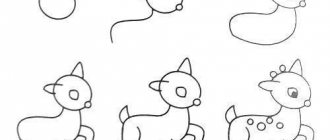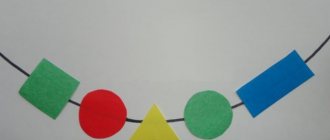Summary of a drawing lesson in the middle group “Pedestrian crossing”
Nadezhda Averyanova
Summary of a drawing lesson in the middle group “Pedestrian crossing”
Purpose: To introduce children to the work of a traffic police officer who regulates traffic on the road.
To consolidate knowledge about traffic lights and their meaning on the road. Expand children's knowledge about the rules of behavior on the street. Develop the desire to remember and follow the rules of safe movement on the street . Teach children to draw a pedestrian crossing , hold the brush correctly, draw straight lines from left to right with the entire bristle of the brush. Develop the child’s attention, speech, memory, fine motor skills of the fingers. Learn independently and carefully bring the initial work to the end.
Preliminary work: Examination of pictures depicting streets, road signs, traffic lights, conversation and examination of a corner in the group on life safety “Traffic Light”. Games with cars and trucks, watching educational films, conversations “Road Safety”. Why are road signs needed? Why is there a traffic light? etc., Reading and conversation based on the book by V. Arbekov “About Smart Animals”
Materials for the lesson : Black piece of paper, white gouache, brush, napkin, model of the road and its parts, cap and baton of a traffic police officer.
Summary of drawing lesson “Road signs are our friends”
Elena Krasnoperova
Summary of drawing lesson “Road signs are our friends”
— consolidate knowledge about traffic ;
- bring to the awareness of children that in a big city all traffic is subject to special rules - traffic .
— improve skills in creating images using various visual media;
- develop the ability to sketch a drawing in pencil before using color.
- develop logical thinking;
— develop readiness to adequately respond to traffic situations and predict their consequences;
- develop a sense of composition, teach children to harmoniously arrange the intended drawing on the plane of the sheet;
- develop creativity, learn to come up with a drawing and translate your idea on paper, independently choosing visual means.
- develop attention, concentration, sense of self-preservation;
— to develop the ability to independently use existing knowledge and previously developed visual skills.
— plot paintings, with images of streets, various city images;
— a set of road signs or their images ;
— split “ signs ”
, for the game
“Collect
a sign ” ;
— sheets of paper in the shape of road signs ;
- colored and simple pencils, felt-tip pens;
Progress of the lesson:
-Children, a traffic police officer came to us, who regulates traffic on the road, with his striped stick.
(The traffic controller shows the movements, and the teacher explains to the children the meaning of the traffic police officer’s gestures) in
— What is a carriageway (children’s answers)
The carriageway is a place where cars, trucks, as well as cyclists and motorcyclists drive.
— What is the name of the part of the road where people walk? (Sidewalk)
People are walking along the sidewalk. You need to walk on the right side of the sidewalk so as not to disturb passers-by.
-Children, where can people cross the road? (children's answers)
Where there is a sign “ Pedestrian crossing ” and wide white stripes are drawn on the road. They are far visible to pedestrians and drivers . And if the traffic light turns green with a little man who allows you to cross the road.
Today we will draw a pedestrian crossing , wide white stripes on black sheets of paper.
Look, we draw white stripes with all the bristles of the brush from left to right on the “carriageway” And we have a “ Pedestrian crossing ”
Look what we came up with!
Reflection: The teacher asks the children questions:
Who came to visit us?
What is he doing on the road?
What is a roadway?
What is the name of the narrow roadway where people walk?
Where can people cross the road ?
What did we draw ?
Well done guys, everyone completed the task, now take the little cars and we’ll play!
Lesson summary “Pedestrian crossing” Lesson Topic: “Pedestrian crossing” Purpose: developing an idea of the “Pedestrian crossing” road sign and its purpose. Preliminary.
Action "Zebra-pedestrian crossing". In the city of Zheleznogorka, Kursk region, teachers Dodurova E. O. and Cherepovskaya Yu. V. MDOU “Kindergarten No. 2 of the combined type “Kapitoshka”. Photo report on a lesson on studying traffic rules in the junior group “Pedestrian Crossing” As part of the city campaign “Pedestrian Crossing”, preventive measures were carried out in our kindergarten with children of all ages. Summary of a drawing lesson in the middle group “Gzhel patterns” Summary of drawing in the middle group “Gzhel patterns” Anastasia Sergeevna Pyatachenko Purpose: To introduce children to Gzhel painting, to teach them. Summary of a lesson on unconventional drawing in the middle group. Lesson notes for the middle group. Unconventional drawing techniques (with cotton swabs) with elements of plasticine painting “Flowers for Mom.”
Summary of a drawing lesson in the middle group “Beauty Butterfly” Objectives: • To introduce children to a new drawing technique - monotype (raw drawing) • To promote the development of children’s imagination and fantasy.
Summary of a drawing lesson in the middle group “Dandelion in a clearing” Summary of a drawing lesson in a middle group “Dandelion in a clearing”. Goal: learn to convey the image of a dandelion in a drawing; exercise in.
GCD "Pedestrian crossing". Direct educational activities through the integration of educational areas “Communication” and “Security” in the junior group.
"Portrait". Summary of a drawing lesson in the middle group Summary of a drawing lesson in the middle group “Portrait” Pyatachenko Anastasia Sergeevna Purpose: To arouse interest in the genre of painting - portrait.
Video “Pedestrian crossing” There is a road on the way to the kindergarten. Transport moves quickly, a lot! There is no traffic light nearby! We need some practical advice. Suddenly my friend barked from his seat: “I know.
Source
On the topic: methodological developments, presentations and notes
Goal:1. Draw the attention of adults and children to the need to comply with traffic rules and ensure road safety.2. Provide d.
Goal:1. Draw the attention of adults and children to the need to comply with traffic rules and ensure road safety.2. Provide d.
Teaching children safe behavior on city streets.
Conversation in the younger group on the topic: “Safe road” Goals: - To cultivate respect for professions. Reinforce the rules of the road with children. Know the colors of traffic lights. - Develop attention, oh.
introduce children to the rules of the road.
SUMMARY OF SUBJECTS ON THE FUNDAMENTALS OF SAFE BEHAVIOR ON THE ROAD “ROAD SAFETY” Senior group (5-6 years old).
Source
Preview:
Municipal budgetary preschool educational institution No. 6 “Nest”
Abstract of GCD for drawing
Compiled by: Rybalchenko M.P.
• To consolidate children's knowledge about warning, prohibitory, prescriptive, information and directional road signs;
• Develop children's attention and creative imagination;
• Reinforce with children the names of road signs and their meanings;
• Develop spatial orientation skills, conscious use of knowledge of traffic rules in everyday life;
• Develop safe behavior skills on the road;
• Cultivate responsiveness (the desire to come to the rescue in difficult times by completing a task);
• Masha and the bear toys;
• “Damaged road signs” (puzzles);
• Image of road signs (prohibitory, informational, prescriptive)
• paper, colored pencils.
Masha and the Bear come to visit the children for a lesson.
Mishka and Masha: Guys, we can’t do it without you.
Educator: Okay, but first we’ll repeat once again what road signs exist and what they mean, and Masha and the bear will listen to us and tell us their opinion.
The guys and I are drivers,
We started our engines. (Rotational movements with arms in front of you)
And then we hit the brakes. (pull the brake handle towards you.)
We close the headlights. (Children close their eyes.)
One two three four five. (count with eyes closed)
when moving forward)
Educator: Are you finished, guys? Masha and the bear, look, did our children cope with the task?
Masha and the bear: Yes, thank you.
Source
Artistic and aesthetic development. Drawing. Topic: “I am a pedestrian.” (middle group)
Artistic and aesthetic development. Drawing.
Educational areas covered:
Cognitive development. Speech development. Social and communicative development. Artistic and aesthetic development
Target:
speech development of middle preschool children with special needs development
develop the ability to create an image of a person in a drawing;
continue to introduce the main parts of the body and their functions (head and neck, arms and legs are attached to the body and can move).
develop the ability to draw large, in accordance with the size of a sheet of paper;
continue to develop the ability to draw individual objects
develop in children a sense of rhythm, composition, and cultivate aesthetic feelings;
consolidate the skills of painting a limited surface.
create conditions for stimulating creative imagination, memory, accumulation of positive emotional experience;
to cultivate friendly relationships in children when analyzing work, to develop such qualities as responsiveness and empathy.
Material
:
sheets of white paper, sets of geometric shapes in envelopes, simple and colored pencils; traffic light image.
Progress of continuous educational activities
:
Joint greeting (psycho-gymnastics):
Let's hold hands together
And we will feel the warmth.
Like our sunshine.
- Guys, today we will continue our conversation about traffic rules.
— What are the rules of the road? (these are rules that all road users must follow).
— Today we will walk around the city. Imagine that we left the kindergarten on the street
and went on foot. (Children move around the group.)
—
What can we be called as road users? That's right, pedestrians.
—Who are “pedestrians”?
—Where can I cross the street? (On transitions.)
— What should you do before crossing the street? (Look to the left, then walk to the middle of the road and look to the right, and then walk the rest of the distance.)
— Why can’t you cross the street at a red traffic light? (Because cars move very fast. You can fall and the driver will not have time to brake.)
2.2.
Outdoor game with speech accompaniment “Cheerful Pedestrian”.
Children stand in a circle at some distance from each other and turn to face the center of the circle.
Abstract of GCD for drawing “Road signs”
PAVLOVA MARINA
Abstract of GCD for drawing “Road signs”
Abstract of GCD for drawing
«Road signs»
• To consolidate children's knowledge about warning, prohibitory, prescriptive, information and directional road signs ;
• Develop children's attention and creative imagination;
• Reinforce with children the names of road signs and their meanings .
• Reinforce knowledge about traffic lights and the meanings of their signals.
• Practice the ability to paint without going beyond the outline of road signs using watercolor paints.
• Develop spatial orientation skills, conscious use of knowledge of traffic rules in everyday life.
• Develop children's attention and creative imagination.
• Develop in children a sense of responsibility in following traffic .




